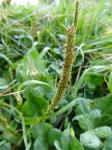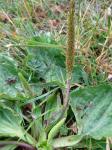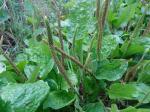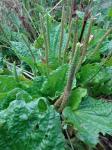Greater Plantain
Plantago major
This common weed, found on meadowland and wasteland has distinctive thick dark green veined leaves that form a flat rosette close to the ground. The plant becomes more noticeable when the tall upright flower stalk develops.
It is one of the most abundant and widely distributed medicinal crops in the world. A poultice of the leaves can be applied to wounds, stings, and sores in order to facilitate healing and prevent infection. The active chemical constituents are aucubin (an anti-microbial agent), allantoin (which stimulates cellular growth and tissue regeneration), and mucilage (which reduces pain and discomfort). Plantain has astringent properties, and a tea made from the leaves can be ingested to treat diarrhoea and soothe raw internal membranes.
Broadleaf plantain is also a highly nutritious wild edible plant that is high in calcium and vitamins A, C, and K. The young, tender leaves can be eaten raw, and the older, stringier leaves can be boiled in stews and eaten.
|












